Before Middletown High School senior Keller Falkenstein exits the locker room to head up to the weight room for his third-period lifting class, he pulls the funnel and water bottle from his locker and adds a heaping spoonful of strange red powder before heading to the water fountain to fill up his bottle.
Walk into the gym at MHS on any given school day, and you will most likely see throngs of student athletes just like Falkenstein mulling around in the weight room, all of their goals the same: get stronger, get bigger, perform better.
“I take a mixture of creatine and pre-workout to start,” said Falkenstein.
That’s just the beginning. After a workout, Falkenstein likes to take three heaping scoops of mass-gaining protein. He currently takes four different types of workout supplements. But why so many?
“I believe they make me stronger, give me an edge on competition and focus me up,” said Falkenstein. “They make me play better on game day.”
And Falkenstein isn’t the only person who feels that way. It’s not uncommon to go into a high school locker room and see lockers filled with two, three or even four different containers of supplements.
Athletes who look to maximize their potential take Individual and Dual Sports, a popular class at MHS, but for some of these athletes the training starts before they step foot in the weight room and continues even after they have finished their final rep.
In a study conducted by the U.S. National Library of Medicine, 92 percent of high school coaches say that they believe their players have turned to using muscle-building supplements. At the college level, 89 percent of student athletes at a Division I university claim to use the same supplements. With incredible pressure to succeed, that’s no surprise.
“I am under a lot of pressure from my coaches as an athlete,” said Erin Smith, an MHS senior and track and field star, “but, mostly, I feel like I put a lot of pressure on myself.”
Smith said that girls are just as likely as boys to take these supplements. Smith takes multiple multivitamins and ends her workouts with a protein shake. It is already well-documented that these types of powders and shakes can provide athletes with the gains and performance that they desire, yet some professionals believe that they can do more harm than good.
The line between supplement and steroid can sometimes be a blurry one, and most athletes are very careful in making selections based on what is legal and what is not for the league in which they compete.
While steroids provide the user with extra organic compounds found in the human body, supplements are typically a pill or powder that provides extra nutrients into the muscles. Even though the two differ in that way, some of the same ingredients appear in both, raising the question, “What is this doing to athletes’ bodies?”
Patrick Withrow, a nutritionist and employee at Complete Nutrition, says that nearly all supplements are safe, as long as the consumer does his or her homework and is aware of his or her personal health.
“If someone is on blood pressure medication and they want to take products to help with weight loss, I would recommend products that are stimulant-free,” said Withrow. “Supplements are safe in moderation and you just need to know yourself.”
Another concern raised is that government testing and approval are not required for workout supplements. The manufacturer of the product is in charge of deciding whether the product is safe for the public, and some of these manufacturers surely do not have the public’s safety as their number one concern.
Short-term effects are one thing. Popular products among high school students such as Cellucor’s “C4 Extreme” pre-workout, which contains creatine, has been documented in causing stomach cramps, headaches and rashes, but some athletes still do not feel like they are using a potentially dangerous substance.
“I don’t see any downsides to using these supplements,” said Falkenstein, “I believe that there are only positives.”
Then there are the long-term effects, which have still not fully been studied in athletes under the age of 18. In a few tests, athletes’ performances were shown to improve in their sports. In other long-term tests, many athletes developed heart and kidney problems and difficulty breathing.
“Anything can have adverse effects if you’re not using products correctly, said Withrow, “If you’re taking a pre-workout, take the recommended dose. What happens is people ignore that and take four scoops because they think the more, the better.”
Mike DeSimone, athletic director for MHS says that athletes have “always been around” as athletes look to gain an edge on competition. DeSimone urges student athletes to be cautious when deciding what goes into his or her body.
“There are a lot of supplements that are not good for you out there,” said DeSimone, “If student athletes aren’t aware of that, it can actually be harmful to them.”
“Consult with parents, and consult with doctors before you use any kind of supplement.”
But ultimately, it’s up the athlete to decide what is best for him or her.
“I firmly believe that everything that goes into my body will affect my performance in some way,” said Erin Smith, “That’s why I always make sure to do my research on everything that I’m taking.”
















